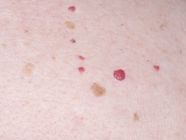Treating eczema in children focuses on using appropriate medical moisturizers for deep hydration and preventing dryness, in addition to topical corticosteroid creams prescribed by the doctor for a limited period to reduce inflammation and itching. In some advanced cases, additional medications may be needed.
It’s worth noting that the doctor may need to try more than one treatment option to determine the most suitable approach for managing your child’s symptoms, as skin response varies from one child to another. Full commitment by parents to the prescribed treatment and the doctor's instructions—such as avoiding triggers and regular moisturizing—is essential. (1)
Moisturizing
Skin should be moisturized at least once or twice a day, even when symptoms are not present, to reduce the likelihood of eczema flare-ups. When the skin is irritated, moisturizing should be increased to several times a day, with a focus on dry and inflamed areas.
It's also important to keep the skin clean, dry, and moisturized. After every bath or handwashing, the skin should be gently dried and immediately moisturized.
Be sure to use fragrance-free moisturizers that do not contain irritants, and opt for thick creams or ointments (which typically contain higher levels of oils and moisturizers) rather than light lotions. (1)
Below is an image showing examples of the best deeply hydrating creams for eczema:

Corticosteroid Creams
Topical corticosteroids are the most commonly used treatment for eczema flare-ups.
Some parents may worry about using corticosteroid creams or ointments, but when used correctly and under medical guidance for a limited period, they are completely safe. Key usage tips include: (2)
- Corticosteroid creams should be used for a short time only, until symptoms subside. Meanwhile, continue using a medical-grade moisturizer daily.
- They are usually applied once or twice a day, depending on the doctor’s instructions.
- Doctors typically prescribe very mild corticosteroids first, such as hydrocortisone 0.5% or 1%, which are very safe. If these are not effective, or if the condition is severe, stronger corticosteroids may be recommended, such as mometasone (Elocon cream) and others.
How Much Corticosteroid Cream Should You Use?
Many parents either underuse or overuse steroid creams. The best way to measure the right dose is using the “fingertip unit (FTU)” method.
If you squeeze the tube until the cream extends from the tip of an adult finger to the first joint (crease), that amount should cover an area equivalent to the size of two adult palms. (3)
Other Medications
In some cases, your doctor may prescribe additional medications, including: (1)
- Topical antibiotics: If signs of bacterial infection appear on the irritated skin, such as severe redness, ulcers, or discharge.
- Oral antihistamines (anti-allergy medications): If the itching is severe and affects your child’s sleep.
- Calcineurin inhibitors: These are topical creams or ointments used for moderate to severe eczema in children over the age of two, such as tacrolimus (Protopic ointment) or pimecrolimus (Elidel cream). They may be used as an alternative to or alongside corticosteroids. (4)
New Treatments: Biologics and JAK Inhibitors
For children with moderate to severe eczema that does not respond well to traditional treatments, there are now advanced options available:
- Biologic treatments, such as Dupixent (dupilumab), target specific pathways in the immune system involved in eczema and are used for children above a certain age under a specialist’s supervision.
- JAK inhibitors, a newer class of oral medications, are also showing promising results in reducing inflammation and controlling eczema symptoms. These are usually prescribed in more complex or resistant cases.
These advanced therapies are typically recommended by dermatologists when conventional treatments are not sufficient or well-tolerated.
Important Tips
- Daily moisturizing is essential – never skip it.
- Use lukewarm water for bathing – keep bath time short (5–10 minutes).
- Use gentle cleansers for sensitive skin – avoid soap-based products, as they strip the skin’s natural oils.
- Watch out for laundry detergent – use hypoallergenic detergents and avoid fabric softeners.
- Avoid known triggers – try to identify what worsens your child’s condition, such as certain foods, fabrics (like wool), pet dander, dust, or extreme temperatures.
- Choose clothes wisely – dress your child in soft, loose-fitting cotton garments. Avoid wool and synthetic fabrics.
- Stick to your treatment plan – follow medication instructions exactly as prescribed when flare-ups occur.
- Maintain your skincare routine – eczema requires full commitment to the care plan recommended by your doctor, even during periods of remission. (1)
Your child’s comfort matters — book an appointment now with our dermatology specialists at Al-Ahli Hospital for safe and effective eczema care.
References
- NHS - Eczema in Children
- Eczema.org - Topical Steroids | Eczema Treatment
- Patient.info - Fingertip Units for Topical Steroids
- Eczema.org - Topical Calcineurin Inhibitors (TCIs).






